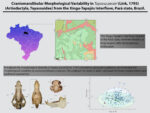Craniomandibular morphological variability in Tayassu pecari (Link, 1795) (Artiodactyla, Tayassuidae) from the Xingu-Tapajós interfluve, Pará State, Brazil
Giulia Pampolha Gomes, José de Sousa Silva Júnior, Juarez Carlos Brito Pezzuti, Alexandra M.R. BezerraVariations in morphological characters can occur at inter- and intraspecific levels. Environmental predictors such as vegetation landscapes, differences in diet, energy requirements, and environmental quality are the factors that could contribute to the variability in skull shape. Because of their wide geographic distribution, species of the family Tayassuidae are excellent models to test ecogeographic and functional hypotheses, being morphologically susceptible to intense selective forces and suffering threats throughout all their range of distribution. To evaluate the morphological diversity of Tayassu pecari (Link, 1795) considering geographic patterns, we investigate the morphological variability in craniomandibular characters in populations from Xingu-Tapajós interfluve, in the Brazilian eastern Amazon, a large region with heterogeneous landscapes. We analyzed 150 skulls of adult individuals for linear morphometrics and qualitative approaches. The results show that there is no significant difference among populations from the study area, but that skulls of Xingu-Tapajós interfluve are larger compared to populations from other localities in Brazil. The species does not follow the Bergmann Rule, being larger in areas closer to the Equator. The intrapopulation results indicate a high gene flow maintained by populations through the Xingu-Tapajós interfluve.
Variabilidade morfológica de Tayassu pecari (Link, 1795) (Artiodactyla, Tayassuidae) no Interflúvio Xingu-Tapajós, Pará, Brasil. Variações em caracteres morfológicos podem ocorrer em níveis interespecífico e intraespecífico. Preditores ambientais como heterogeneidade de paisagens, diferenças na dieta, demandas energéticas e qualidade ambiental, são fatores que podem contribuir para a variabilidade no formato do crânio. Devido sua ampla distribuição geográfica, espécies da família Tayassuidae são vistas como modelos excelentes para testar hipóteses ecogeográficas e funcionais, sendo morfologicamente suscetíveis a intensas forças seletivas e sofrendo ameaças por toda sua área de distribuição. Com o intuito de entender a diversidade morfológica em Tayassu pecari (Link, 1795), considerando padrões geográficos, investigamos a variabilidade morfológica em caracteres craniomandibulares de populações presentes no interflúvio Xingu-Tapajós, localizado na Amazônia oriental brasileira, sendo uma região ampla e com paisagens heterogêneas. Analisamos 150 crânios de indivíduos adultos para morfometria linear e abordagens qualitativas. Os resultados demonstram que não há diferença significativa entre as populações na área de estudo, mas que esses espécimes apresentam crânios maiores quando comparados com populações de outras regiões do Brasil. A espécie não segue a Regra de Bergmann, sendo maior em áreas próximas à linha do Equador. Os resultados intrapopulacionais sugerem um alto fluxo gênico mantido pelas populações através do interflúvio Xingu-Tapajós.
